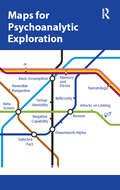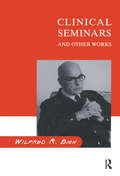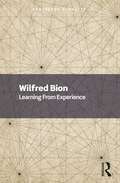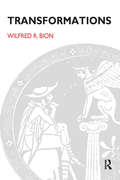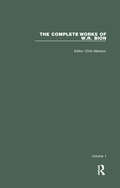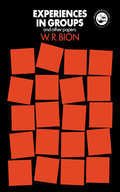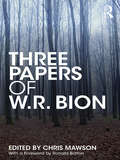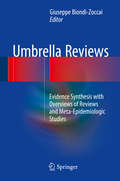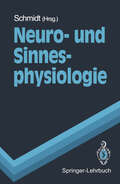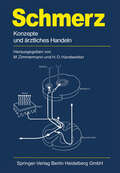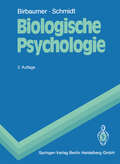- Table View
- List View
Maps for Psychoanalytic Exploration
by Parthenope Bion TalamoMaps for Psychoanalytic Exploration brings together the author's main works, until now published only in Italian. They are made available to a wider readership in this volume through a translation into English by Shaun Whiteside, supported by the generosity of the members of the Melanie Klein Trust. In these chapters the author explores important implications of her father's ideas at different levels of psychic and social organisation. Her writing is very clear and, as Dr Anna Bauzzi, the Editor of the Italian edition, writes in her Introduction, the quality of it makes many of Bion's ideas more accessible, without any reduction of their complexity.
Maps for Psychoanalytic Exploration
by Parthenope Bion TalamoMaps for Psychoanalytic Exploration brings together the author's main works, until now published only in Italian. They are made available to a wider readership in this volume through a translation into English by Shaun Whiteside, supported by the generosity of the members of the Melanie Klein Trust. In these chapters the author explores important implications of her father's ideas at different levels of psychic and social organisation. Her writing is very clear and, as Dr Anna Bauzzi, the Editor of the Italian edition, writes in her Introduction, the quality of it makes many of Bion's ideas more accessible, without any reduction of their complexity.
Clinical Seminars and Other Works
by Wilfred R. BionThis selection of clinical seminars held by Wilfred Bion in Brasilia (1975) and Sao Paulo (1978) is the nearest we shall ever get to experiencing his application of his theories and views to consulting-room practice. It is also likely to be the only printed record of this area of his work. As those who underwent analysis with Bion will testify, nothing can approach the experience of the thing itself, but, failing that, these seminars may help to fill the gap now that his voice can only be heard through his published writings and lectures.
Clinical Seminars and Other Works
by Wilfred R. BionThis selection of clinical seminars held by Wilfred Bion in Brasilia (1975) and Sao Paulo (1978) is the nearest we shall ever get to experiencing his application of his theories and views to consulting-room practice. It is also likely to be the only printed record of this area of his work. As those who underwent analysis with Bion will testify, nothing can approach the experience of the thing itself, but, failing that, these seminars may help to fill the gap now that his voice can only be heard through his published writings and lectures.
Learning From Experience (Routledge Classics)
by Wilfred R BionWilfred R. Bion was one of the foremost psychoanalysts of his generation, whose work has shaped and enriched psychoanalysis and psychotherapy indelibly. Renowned for some highly original and sometimes cryptic ideas, such as the alpha function and theory of the grid, Learning from Experience is arguably his most important and enduring work. Bion brings knowledge into the psychoanalytic spotlight. What forces, he asks, interfere with knowledge? Crucially, Bion doesn't mean knowing only facts, but the lifelong process of understanding and coming to know things that is a consequence of the development of knowledge. However, Learning From Experience is perhaps best-known for its emphasis on the way emotion and knowledge are interwoven. Bion links the emotional capacity to develop and know to the capacity to tolerate frustration: if we can hold ourselves in check whilst we endure frustration, then we can come to know things. A remarkable and brilliant work by a fascinating psychoanalyst and thinker, Learning From Experience continues to inspire psychoanalysis and psychotherapy. This Routledge Classics edition includes a new Foreword by Robert Hinshelwood.
Learning From Experience (Routledge Classics)
by Wilfred R BionWilfred R. Bion was one of the foremost psychoanalysts of his generation, whose work has shaped and enriched psychoanalysis and psychotherapy indelibly. Renowned for some highly original and sometimes cryptic ideas, such as the alpha function and theory of the grid, Learning from Experience is arguably his most important and enduring work. Bion brings knowledge into the psychoanalytic spotlight. What forces, he asks, interfere with knowledge? Crucially, Bion doesn't mean knowing only facts, but the lifelong process of understanding and coming to know things that is a consequence of the development of knowledge. However, Learning From Experience is perhaps best-known for its emphasis on the way emotion and knowledge are interwoven. Bion links the emotional capacity to develop and know to the capacity to tolerate frustration: if we can hold ourselves in check whilst we endure frustration, then we can come to know things. A remarkable and brilliant work by a fascinating psychoanalyst and thinker, Learning From Experience continues to inspire psychoanalysis and psychotherapy. This Routledge Classics edition includes a new Foreword by Robert Hinshelwood.
Transformations
by Wilfred R. BionTransformations continues the investigation of various aspects of psychoanalytic theory and practice which the author commenced with Learning from Experience (1962) and pursued in Elements of Psychoanalysis (1963). In this third work published in 1965, the author examines the ways in which the analyst's description of the original analytic experience, mediated by theory, necessarily transforms it in the course of effecting an interpretation.
Transformations: Change From Learning To Growth
by Wilfred R. BionTransformations continues the investigation of various aspects of psychoanalytic theory and practice which the author commenced with Learning from Experience (1962) and pursued in Elements of Psychoanalysis (1963). In this third work published in 1965, the author examines the ways in which the analyst's description of the original analytic experience, mediated by theory, necessarily transforms it in the course of effecting an interpretation.
The Complete Works of W.R. Bion: Volume 1
by W.R BionThis book is a reminiscence of the first twenty-one years of the Wilfred R. Bion's life from 1897 to 1919: eight years of childhood in India, ten years at public school in England, and three years in the army.
The Complete Works of W.R. Bion: Volume 1 (The\complete Works Of W. R. Bion Ser.)
by W.R BionThis book is a reminiscence of the first twenty-one years of the Wilfred R. Bion's life from 1897 to 1919: eight years of childhood in India, ten years at public school in England, and three years in the army.
Experiences in Groups: and Other Papers
by W.R. BionA classic study which, by synthesizing the approaches of psychoanalysis and group dynamics, has added a new dimension to the understanding of group phenomena.
Experiences in Groups: and Other Papers
by W.R. BionA classic study which, by synthesizing the approaches of psychoanalysis and group dynamics, has added a new dimension to the understanding of group phenomena.
Three Papers of W.R. Bion
by W.R. BionThree Papers of W.R. Bion features two previously unpublished papers and one which has only previously appeared in The Complete Works of W. R. Bion (2014). Characterised by Bion’s directness, clarity and intensity, together they illustrate important aspects of his later thinking. They also show Bion using his key ideas in fresh contexts which will allow readers already familiar with his theoretical and clinical concepts to appreciate them from a new angle. The first paper, Memory and Desire, clarifies one of Bion’s most important and clinically-relevant ideas: the value of suspending elements of our memory and desire in the service of allowing openness to psychoanalytic intuition. The second, Negative Capability, was reformulated to become the final chapter of his 1970 Attention and Interpretation. The publication here of the original paper allows an interesting and rewarding three-way comparison to be made with the 1970 chapter, and Memory and Desire. The third paper, Break Up, Break Down, Break Through, was presented without notes in 1976 in Los Angeles and the transcript from the recorded talk is published here for the first time. It displays the complex interweaving of the personal and the theoretical and offers a fascinating contribution to the study of what Bion called "the turbulence that obeys no man-made ‘laws of nature’". Wilfred R. Bion’s writing continues to be read and re-read by an increasing and widening readership; the three papers presented here possess contemporary clinical relevance and each have a bearing on the underlying philosophical basis of psychoanalytical work and thinking.
Three Papers of W.R. Bion
by W.R. BionThree Papers of W.R. Bion features two previously unpublished papers and one which has only previously appeared in The Complete Works of W. R. Bion (2014). Characterised by Bion’s directness, clarity and intensity, together they illustrate important aspects of his later thinking. They also show Bion using his key ideas in fresh contexts which will allow readers already familiar with his theoretical and clinical concepts to appreciate them from a new angle. The first paper, Memory and Desire, clarifies one of Bion’s most important and clinically-relevant ideas: the value of suspending elements of our memory and desire in the service of allowing openness to psychoanalytic intuition. The second, Negative Capability, was reformulated to become the final chapter of his 1970 Attention and Interpretation. The publication here of the original paper allows an interesting and rewarding three-way comparison to be made with the 1970 chapter, and Memory and Desire. The third paper, Break Up, Break Down, Break Through, was presented without notes in 1976 in Los Angeles and the transcript from the recorded talk is published here for the first time. It displays the complex interweaving of the personal and the theoretical and offers a fascinating contribution to the study of what Bion called "the turbulence that obeys no man-made ‘laws of nature’". Wilfred R. Bion’s writing continues to be read and re-read by an increasing and widening readership; the three papers presented here possess contemporary clinical relevance and each have a bearing on the underlying philosophical basis of psychoanalytical work and thinking.
Dimensional Psychopathology
by Massimo Biondi Massimo Pasquini Angelo PicardiThis book presents an innovative approach to clinical assessment in psychiatry based on a number of psychopathological dimensions with a presumed underlying pathophysiology, that are related to fundamental phenomenological aspects and lie on a continuum from normality to pathology. It is described how the evaluation of these dimensions with a specific, validated rapid assessment instrument could easily integrate and enrich the classical diagnostic DSM-5 or ICD-10 assessment. The supplemental use of this dimensional approach can better capture the complexity underlying current categories of mental illness. The findings from a large patient sample suggest how this assessment could give a first glance at how variable and multifaceted the psychopathological components within a single diagnostic category can be, and thereby optimise diagnosis and treatment choices. Being short and easy to complete, this dimensional assessment can be done in a busy clinical setting, during an ordinary psychiatric visit, and in an acute clinical context, with limited effort by a minimally trained clinician. Therefore, it provides interesting and useful information without additional costs, and allows research work to be performed even in difficult settings.
Empathy, Normalization and De-escalation: Management of the Agitated Patient in Emergency and Critical Situations
by Massimo Biondi Massimo Pasquini Lorenzo TarsitaniThis book describes theory and techniques of empathic communication, normalization and de-escalation procedures for the management of aggressive or violent patients in clinical critical settings'. Consisting of 9 chapters, it discusses in detail the self-regulation of empathy in potential dangerous interactions, as well as common mistakes and nonprofessional reactions. It also explores the basic concept of neurobiology of violence and aggression behaviour, such as brain circuitry and neuromodulators, and other rapid tranquillization guidelines. The final chapter focuses on the crucial topics of post-aggression debriefing.Based on the clinical experience of the editors and authors, who work in emergency psychiatry settings, the book offers practical key expressions to promote a normalization talk, to calm agitated individuals, and to prevent crises both for psychiatric patients and people without mental disorders.It is a useful tool to help readers gain confidence as mediators in critical circumstances and will be of interest for a wide range of practitioners in healthcare settings, from psychiatrists and psychologists, to nurses and other healthcare workers.
The Clinician in the Psychiatric Diagnostic Process
by Massimo Biondi Angelo Picardi Mauro Pallagrosi Laura FonziThe vast majority of mental health clinicians and researchers rely on diagnostic systems based on operational criteria. However, in their everyday practice, many clinicians also pay attention to their own feelings or intuitions about the patient. For an even greater number of clinicians, this process may occur inadvertently. Scholars from various fields are increasingly stressing the importance of complementing the emphasis on operational criteria with thoughtful attention to the subjective and intersubjective elements involved in a thorough psychopathological evaluation. This book aims at capturing the essence, implications and full potential of the clinician’s subjective experience in the diagnosis and treatment of mental disorders. It gathers contributions from several different disciplines, such as phenomenology, neuroscience, the cognitive sciences, and psychoanalysis. It also presents the development, validation, and clinical application of a psychometric instrument that reliably investigates the clinician’s feelings, thoughts, and perceptions related to the clinical encounter.
Diagnostic Meta-Analysis: A Useful Tool for Clinical Decision-Making
by Giuseppe Biondi-ZoccaiThis book is the first exclusively devoted to the systematic synthesis of diagnostic test accuracy studies. It builds upon the major recent developments in reporting standards, search methods, and, in particular, statistical tools specifically devoted to diagnostic studies. In addition, it borrows extensively from the latest advances in systematic reviews and meta-analyses of intervention studies. After a section dedicated to methods for designing reviews, synthesizing evidence and appraising inconsistency in research, the application of these approaches is demonstrated in the context of case studies from various clinical disciplines. Diagnosis is central in medical decision-making, and in many other fields of human endeavor, such as education and psychology. The plurality of sources of evidence on diagnostic test accuracy poses a huge challenge for practitioners and researchers, as do the multiple dimensions of evidence validity, which include sensitivity, specificity, predictive values, and likelihood ratios. This book offers an invaluable resource for anyone aiming to improve decision-making processes in diagnosis, classification or risk prognostication, from epidemiologists to biostatisticians, radiologists, laboratory physicians and graduate students, as any physician interested in refining his methodological skills in clinical diagnosis.
Umbrella Reviews: Evidence Synthesis with Overviews of Reviews and Meta-Epidemiologic Studies
by Giuseppe Biondi-ZoccaiThis book is an ideal guide to umbrella reviews, overviews of reviews, and meta-epidemiologic studies for evidence synthesis. Research is conducted at different levels: primary research consists of original studies while secondary research comprises qualitative reviews, systematic reviews, and meta-analyses. Recently, a novel further level of research has been introduced, based on the analysis and pooling of reviews and meta-analysis. This book is the first to focus solely on this new type of research design, which permits a comprehensive and powerful synthesis of scientific evidence in medicine as well as in many other fields in order to inform decision-making. All aspects are covered, including review design and registration, the searching, abstracting, appraisal, and synthesis of evidence, the appraisal of moderators and confounders, and state of the art reporting. Case studies in a range of medical specialties are then presented. The hands-on approach of the book, written by a multinational team of experts, will enable the reader to interpret and independently conduct umbrella reviews.
The Courage of Simplicity: Essential Ideas in the Work of W.R. Bion (The New International Library of Group Analysis)
by Hanni BiranRelying on and developing the ideas of W.R. Bion, this book observes psychoanalytic thinking through three prisms: person, group and society. The book is divided into four sections. The first revolves around the individual. Clinical in its emphasis, it discusses Bion's theory of thinking, his reading of the Oedipus myth and his notion of the "selected fact". These are illustrated by vignettes highlighting the emotional aspect of thinking. The second discusses the small group and its unconscious processes. Although Bion's paradigms have greatly influenced psychoanalytic conceptions of small group processes, this section integrates the thinking of Bion with that of Klein, Foulkes, Turquet, Lawrence and Hopper. The third, focusing on the feelings of despair and helplessness in the face of repetitive, unending war, is inspired by the author's life in Israel. It relates to society at large and the traumatic history of the Jewish people: the Holocaust is still inscribed in the Israeli social-unconscious and this social trauma has considerable impact on the Jewish-Arab conflict.
The Courage of Simplicity: Essential Ideas in the Work of W.R. Bion (The New International Library of Group Analysis)
by Hanni BiranRelying on and developing the ideas of W.R. Bion, this book observes psychoanalytic thinking through three prisms: person, group and society. The book is divided into four sections. The first revolves around the individual. Clinical in its emphasis, it discusses Bion's theory of thinking, his reading of the Oedipus myth and his notion of the "selected fact". These are illustrated by vignettes highlighting the emotional aspect of thinking. The second discusses the small group and its unconscious processes. Although Bion's paradigms have greatly influenced psychoanalytic conceptions of small group processes, this section integrates the thinking of Bion with that of Klein, Foulkes, Turquet, Lawrence and Hopper. The third, focusing on the feelings of despair and helplessness in the face of repetitive, unending war, is inspired by the author's life in Israel. It relates to society at large and the traumatic history of the Jewish people: the Holocaust is still inscribed in the Israeli social-unconscious and this social trauma has considerable impact on the Jewish-Arab conflict.
Physiologische Psychologie: Eine Einführung an ausgewählten Themen. Für Studenten der Psychologie, Medizin und Zoologie
by N. BirbaumerDas vorliegende Buch soll an Beispielen einiger aktueller Probleme aus dem Bereich der physiologischen Psychologie einen ersten Ein stieg in diesen Teilbereich der experimentellen Psychologie ermög lichen. Nach Meinung des Autors sollte eine Einführung in ein neues naturwissenschaftliches Fachgebiet nicht über eine umfang reiche und möglichst erschöpfende Wissensvermittlung erfolgen, sondern die Grundfragen dieser Wissenschaft sollen an einfachen und möglichst praktisch und theoretisch relevanten Beispielen er läutert werden. - Die große Bedeutung der physiologischen Psy chologie für eine Theorie des menschlichen Verhaltens ist heute un bestritten. Damit wird dieser Wissenschaftszweig potentiell auch für die psychologische und medizinische Praxis relevant; ein un mittelbarer Anwendungs- und Verwertungszusammenhang wird aber häufig nicht gesehen oder nicht diskutiert. Auch in dieser Einführung werden erst im letzten Kapitel Anwendungsmöglich keiten ausführlich besprochen, da in diesem Bereich (Emotion) bereits mehr empirisches Material vorliegt. Die praktische Verwer tung der hier dargestellten Befunde wird in den nächsten Jahren stark zunehmen. Ein Motiv für diese Arbeit war daher die Not wendigkeit, eine Grundlage für eine kritische Auseinandersetzung angesichts der wachsenden Bedeutung der physiologischen Psy chologie für die Verhaltenswissenschaften zu schaffen. Trotz dieser Tatsachen und der Verankerung des Faches "Physio logische Psychologie" in den Ausbildungs- und Prüfungsordnungen für Psychologen und Mediziner liegt kein einführendes Buch zu diesem Wissenszweig im deutschen Sprachraum vor. Eine sinnvolle und wahrscheinlich notwendige Ergänzung zu dieser "Einführung an Beispielen" kann in einem der vielen ausgezeichneten Lehr bücher über "Physiological Psychology" gesehen werden (z. B. GROSSMAN, 1967, oder DEUTSCH und DEUTSCH, 1973).
Neuro- und Sinnesphysiologie (Springer-Lehrbuch)
by N. Birbaumer V. Braitenberg J. Dudel U. Eysel H. O. Handwerker H. Hatt M. Illert W. Jänig R. Rüdel R. F. Schmidt A. Schüz H. P. ZennerDieses Buch informiert über die gesicherten Grundlagen und die wesentlichsten neueren Ergebnisse der Erforschung des peripheren und zentralen Nervensystems und der Sinnesorgane des Menschen. Dabei wurde der Umfang so begrenzt, daß der Inhalt in angemessener Zeit aufgenommen werden kann. Das Buch setzt praktisch keine anatomischen oder physiologischen Vorkenntnisse voraus. Alle Leser, die das Abitur oder diesem vergleichbare Kenntnisse der Naturwissenschaften besitzen, können sich den Inhalt somit ohne Verständnisschwierigkeiten aneignen. Dabei wird der Lernprozeß durch die Didaktik des Lehrbuches und die zahlreichen vierfarbigen Abbildungen zusätzlich unterstützt. Alle zwölf Autoren dieses Buches gelten international als besonders kompetente Fachleute auf ihrem jeweiligen Forschungsgebiet. Damit ist gewährleistet, daß dieses Lehrbuch nicht nur die wesentlichen Fakten und Hypothesen der Neuro- und Sinnesphysiologie vermittelt, sondern darüber hinaus auch an die noch offenen Fragen der Hirnforschung heranführt. Somit wendet sich dieses Werk neben Medizinstudenten auch an Physiologiestudenten anderer Fachgebiete wie Biologie, Psychologie, Zahnmedizin und Pharmazie.
Schmerz: Konzepte und ärztliches Handeln
by N. Birbaumer K. Brune H. O. Handwerker A. Herz R.W.C. Janzen H. Seemann H. Tilscher M. Zenz M. ZimmermannSchmerz ist einer der Angelpunkte der ärztlichen Tätigkeit. Als aku ter Schmerz ist er das wichtigste Symptom, das den Patienten zum Arzt führt und bei der Krankheitsdiagnose entscheidende Hinweise liefert. Der chronische Schmerz dagegen, oft Hauptursache für das Leiden eines Patienten, ist eine der dringendsten und dabei auch schwierigsten Aufgaben der Therapie. Angesichts dieser Wichtigkeit des Schmerzes für den Arzt ist es verwunderlich, daß der Schmerz im Medizinstudium bisher wenig Gewicht hatte. Dieser Mangel wird vom Arzt oft erst während der praktischen Tätigkeit erkannt, wenn er feststellt, daß bei seinem Stu dium der Schmerz zwar in mehreren klinischen Fächern erörtert wurde, daß er jedoch kein für die Praxis brauchbares Konzept für Schmerzdiagnose und Schmerztherapie von der Universität mit brachte. Aus dieser Erkenntnis heraus versuchen wir, mit diesem Buch ei ne Anleitung für eine Lehreinheit über Schmerz im Medizinstudium zu geben. Entsprechend diesem Vorschlag soll der Medizinstudent während eines Semesters im klinischen Studienabschnitt eine inter disziplinär organisierte Vorlesungsreihe angeboten bekommen. Ziel der Veranstaltung soll es sein, dem Studenten aus der Sicht der ein schlägigen theoretischen und klinischen Fächer ein zusammenhän gendes Bild von Schmerz und Schmerzbehandlung zu vermitteln. Die Herausgeber haben im Rahmen einer Ferienakademie der Stu dienstiftung des Deutschen Volkes zusammen mit Prof. Gerbers hagen vom Schmerzzentrum Mainz beispielhaft eine solche syn optische und interdisziplinäre Darstellung über Schmerz gegeben.
Biologische Psychologie (Springer-Lehrbuch)
by Niels Birbaumer Robert F. SchmidtDer große Erfolg machte bereits nach kurzer Zeit eine Neuauflage notwendig. Die verbesserte 2. Auflage bietet eine übersichtliche und umfassende Einführung in die biologischen und physiologischen Grundlagen des Verhaltens: Von der Einzelzelle bis zu den Denkprozessen wird der neueste Wissensstand dargestellt. Das Gehirn wird dabei nicht nur als biologische Größe betrachtet, die psychisches Erleben und Verhalten "hervorbringt", sondern als ein in ständigem Austausch mit den Umweltgegebenheiten und den vererbten Eigenschaften befindliches dynamisches System. Die didaktisch übersichtliche Darstellung mit zahlreichen hervorragenden Abbildungen erleichtert sowohl dem Anfänger den Einstieg als auch dem Fortgeschrittenen die Aktualisierung seines Wissens. Das Buch ermöglicht somit nicht nur eine ökonomische Prüfungsvorbereitung, sondern führt den Leser zu einem Verständnis des komplexen Zusammenwirkens physiologischer Gesetzmäßigkeiten mit Verhaltensprinzipien.
